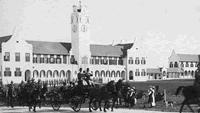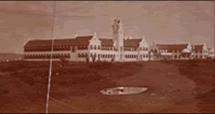Soon after the landing of the British Settlers in 1820, a small but flourishing settlement existed on the shores of Algoa Bay.
Any form of organised education, however, was sadly lacking until the arrival of a Scottish graduate named John Paterson, who must be given most of the credit for establishing a small state-aided school in Chapel Street shortly after his arrival in 1839. He got Sir George Grey interested, and Sir George, being the Governor of the Cape Colony, made land available for endowment and set up a Board of Enquiry in 1855.
John Paterson was a remarkably active man. In addition to his own business interests, he became a member of Parliament and was responsible for the establishment of the Standard Bank of South Africa. His big effort in getting Sir George Grey to take an interest in education led to the growth of the School to which Sir George gave his name, and the first headmaster was a Mr J. R. Macleish.
In 1862, after the death of Mr Macleish, the school committee decided to advertise overseas for a Rector, a status to which the school was entitled because the Institute had revenue for Crown Lands. The Rev. H. I. Johnson became the first Rector and held the position from 1863 to 1872. He was followed by Rev. J. Thurlow, Mr J. Vipan and Mr E. Noaks.
The arrival of Mr W. Chubb Meredith in 1892 was to be significant. It was he who started the Old Grey’s Union, established a Cadet Corps, introduced school colours and encouraged sport. He actually started the Grey magazine and wrote the words of the School Song.
Mr Meredith died in 1910 and was succeeded by Mr William Archer Way, who during his 17 years, undertook the colossal task of moving to and firmly establishing the School on its present site. He also encouraged the establishment of the boarding school. Coming from Graaff-Reinet, where he had been a headmaster, Mr Way, who had obviously made a major impact in the Karoo, found several boys following him to Port Elizabeth and helping to make the boarding school a viable proposition. In the 1920’s, the number of pupils increased to such an extent that plans had to be made for the erection of a new and separate Junior School on the estate.
Mr Way’s successor in 1928 was Mr James Lang who introduced the school house system to Grey, naming the houses after the six Rectors mentioned above – Johnson, Thurlow, Vipan, Noaks, Meredith and Way. In 1930, the Grey Junior school came into being under its first Headmaster, Mr E.G. Draycott. From this time, the name Grey Institute disappeared and the titles Grey High School and Grey Junior School came into existence. Mr Lang gave unsparingly of his time and energy for 14 years (1928-1942), the last three of which were the early and dark years of World War II. He left to his successor, Mr Bruce Gordon, a well-organised school, rich in tradition and highly respected throughout the land. When Mr Draycott died in 1945, he was succeeded as headmaster of the Junior School by Mr S.F. Edwards who had previously served on the staff of the High School since 1929.
In the post-war years, steady progress and development continued and in 1956, the Grey celebrated its centenary. Its first 100 years have been faithfully recorded in “Neath the Tower”, authored by J. Redgrave, A Pollock and J. Hattle. After a highly successful term of office, Mr Gordon was succeeded in 1958 by Mr O.B. Taylor whose term of office was cut short by illness. Since 1962 under Stan Edkins (1963-1976), Dieter Pakendorf (1977-1992) and Roy Simpson (1993-2001), tremendous development and growth in stature has continued and has been recorded in “Neath the Tower – Part II” authored by J. Hattle.
A school boasting such history must surely have a few resident ghosts…?
Fortunately there are a few..
Former rector William Archer Way still wanders the dark corridors at night; OB Taylor is still seen at the rectory; a matron not of this world is forever adjusting the pictures in the matron’s residence and sports coach Nick Kruger haunts the arch under which he suffered a fatal heart attack..


